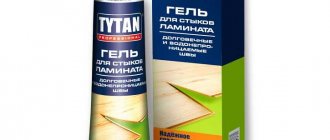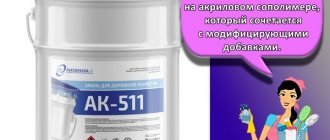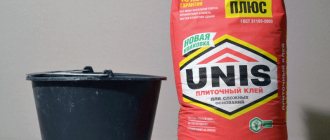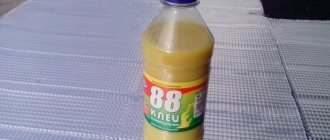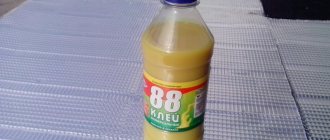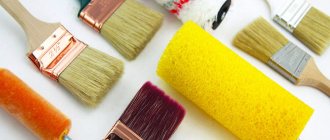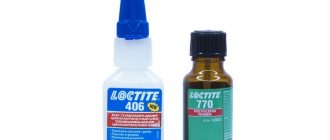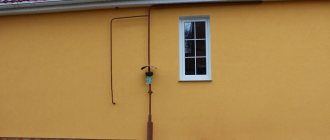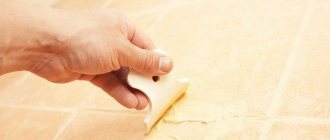What is an adhesive composition
Today there are many building substances that are used to fix different types of materials. Typically, such mixtures mean cement or a special adhesive composition for tiles. But in reality, there are much more compounds and their varieties.
Separately, it is worth mentioning gypsum glue. It is often used in such cases:
- When fastening tongue-and-groove slabs and gypsum fiber sheets. Such materials are impressive in size. They are used for the rapid construction of partitions. Therefore, it is worth using a composition that sets in a short time. In such a situation, instead of polyurethane foam, it is advisable to use gypsum glue.
- For finishing coatings with artificial stone. The substance is also suitable for fastening gypsum tiles. This composition is often used for indoor work.
- If you need to attach plasterboard sheets to the ceiling or walls. They are used as a rough finish.
This type of glue has many advantages, which makes it one of the most popular materials. These include the following:
- ease of making the solution - instructions are given on each package;
- absence of lumps in the mixture;
- quick drying of the mixture - this helps to complete all tasks in a short time;
- high adhesive strength after drying;
- possibility of working without the use of a frame;
- economical consumption;
- the ability to apply the substance in a thin layer, which helps save room space;
- durability of the coating.
At first it seems that gypsum glue has no disadvantages. However, in comparison with other substances, it is worth highlighting the following disadvantages:
- the fragility of the composition after hardening - therefore the substance is not suitable for installing floor coverings;
- lack of moisture resistance - upon contact with liquid, the glue loses its characteristics, therefore it is prohibited to use it for cladding outside or in conditions of high humidity.
Types of glue
In most cases, decorative gypsum tiles for interior decoration are small plates that retain a textured surface and a smooth back side. It is on this that the mixture is applied. To glue and organize installation, different types of compositions are used.
Alabaster mixtures
These are dry types of compositions that contain plasticizers and alabaster. They are diluted with the addition of a certain amount of water. A liquid nail will not require this.
Sometimes quartz sand is added to make production cheaper. But because of this, adhesion deteriorates, so purchasing such materials is not recommended.
The minimum pot life of the glue is half an hour. It is better to give preference to quick setting. Then you won’t have to hold the elements on the surface with your own hands for a long time in order to reliably glue the gypsum stone.
To dilute high-quality glue, you need to take at least 300 milliliters of liquid per kilogram of dry powder. It is recommended to study the instructions in advance. Otherwise, there will be too little alabaster, which will cause the adhesive properties to deteriorate.
Liquid Nails
You can also glue gypsum stone onto them without worrying about adhesion. But there are different types.
- With neoprene.
Toxic material that emits an unpleasant odor. But it can fix gypsum cladding on any type of base. The main thing when working is to protect the respiratory system and organize timely ventilation of the room. Laying out the first corner will not be difficult.
- With acrylic copolymers or polyurethanes.
In this case, the toxicity of the composition is minimized, and there is no specific odor. An excellent option if you need to mount porous materials. Moisture resistance is low; such compositions do not tolerate low temperatures. This must be taken into account when laying gypsum bricks.
What varieties are there?
Almost all types of mounting adhesive are made on a dry basis. It usually has a white tint. Sometimes there are gray mixtures. This variety is considered the most successful. To improve adhesion characteristics, additional components are often added to gypsum. They help improve the composition of the product. Another type of mixture is glue with quartz. This component helps reduce the cost of the composition. Well-known manufacturers practically do not use this substance.
See also
Composition and technical characteristics of CMC glue, instructions for use
The properties of gypsum adhesive vary depending on the number of additional components. The main function of the substance is considered to be assistance in the installation of various structures. Thanks to its use, it is possible to achieve reliable adhesion of the working composition to the surface being treated.
To get excellent results, use compositions that contain a lot of gypsum.
The amount of water indicated in the instructions will help determine the level of adhesion. If 1 kilogram of glue requires 0.3 liters of water, you should be sure that there is not as much gypsum in the substance as other components. This means that the adhesive characteristics of such a substance are not very high. As a result, the material may delaminate even at the initial stage.
Rules of application
When working, it is important to observe temperature intervals. For gluing you will need a trowel and a notched spatula.
Preparatory work
Before starting cladding you need:
- cleaning from dust, dirt, old finishing materials, paint;
- degreasing with solvents;
- surface drying;
- when laying a heated floor, turn it off a day before work;
- primer treatment of highly absorbent substrates;
- preventing contact with water, providing the necessary waterproofing.
Breeding rules
When diluting glue, you must use safety glasses and a respirator. Knauf is diluted in the following proportion: 1 glass of water is required for 1 kg of dry glue. First, the liquid is poured, after which the powder is added, the mass is kneaded with a construction mixer until a homogeneous solution is obtained. Cover the finished mixture with a lid for 5 minutes, after which it is mixed again.
How to work with glue
Take the glue with a trowel and place it on a spatula. Apply to the wall or floor, distribute the glue evenly over the surface, then run the teeth of a spatula over the adhesive layer. For exterior work, apply glue also to tiles. After this, apply the facing material and press it well to the base. Immediately wipe off the exposed layer of glue with a damp cloth. When working with glue, avoid direct sunlight and drafts. Work must be done with gloves.
Main manufacturers
Today there are many adhesive compositions that are made on the basis of gypsum. It is worth highlighting a number of popular companies that offer quality products.
Knauf
The product of this company is sold in packages of 30 kilograms. The substance is considered very reliable and has an optimal price-quality ratio. This is why adhesives from the German brand have remained popular for many years.
Volma
This domestic manufacturer produces gypsum adhesive in accordance with unique technology. The brand’s composition is often used by builders, calling it one of the highest quality. In addition to its excellent properties, users note the convenient packaging of the product.
Typically, such glue is sold in 30-kilogram bags, while Volma offers ten-kilogram packages. In addition, the price of Russian brand products is significantly lower than imported analogues, and the quality is at a high level.
Gypsum polymer
This manufacturer is a partner of the German brand Knauf, which offers ingredients for the production of gypsum substance. The cost of Gypsopolymer products is much lower than its analogues, but this in no way affects the quality of the product.
Magma
This company was established in 2005. Every year she only strengthens her leadership position. The production of dry mixtures is carried out using German equipment. In this case, foreign technologies and recipes are used. The cost of glue remains quite affordable.
Work order
How to properly glue drywall with glue? You can use one of three existing technologies. They differ quite a bit, and mainly depend on the level of different curvature.
The general procedure is not violated:
- Initially, electrical wiring is laid;
- Work is being carried out to prepare surfaces using grooves with leads in the right places;
- A primer layer is applied;
- The sheets are prepared, sized and cut;
- Preparation of the adhesive mass;
- Applying it to the prepared surface;
- Installation stage for plasterboard sheets.
Features of choice
When choosing an adhesive, it is worth considering the main indicator - the composition of the product. Be sure to take into account the ratio of water and gypsum. The setting and drying time of the solution is of no small importance. The quality composition should have short-term parameters, since they affect the pace of construction work.
Many manufacturers offer types of gypsum that retain their properties for an hour after mixing with water. But this parameter is not considered a reference, since the level of adhesion is determined by the material that needs to be fixed. It usually retains its characteristics for 30-70 minutes.
See also
Types and requirements for leather glue, rules of application
How is it different from polyurethane foam?
Polyurethane foam or adhesive foam? It is difficult for an ignorant person to understand. To understand the difference between these materials, you need to compare them. Polyurethane foam is a polyurethane sealant. Purpose: installation. Additionally, it has sound-proofing and heat-insulating properties. Used when installing doors, sealing cracks, sealing seams. It can be used to fix building materials, but the expansion it gives when hardening makes fixation problematic.
Adhesive foam is a polyurethane adhesive. Its main function is to connect parts. It differs from polyurethane foam in its qualities. Its adhesive ability and adhesion are many times better than polyurethane foam. This is achieved through special additives. Foam adhesive does not expand. Its increase in volume is minimal. In order to evenly glue the panel to the wall with mounting foam, additional fixation is needed. Otherwise, the foam, expanding, will raise the slab. When working with foam adhesive, no fixing devices are required. The panel is simply applied to the wall and pressed.
Recommended Brands
There are many options for gypsum adhesive, each of which has certain characteristics.
Plusfix
This adhesive in powder form is made from sand and cement. It also contains cellulose. The substance is used to fix small decorative bricks. They can also be used to attach tiles with a maximum size of 25x25 centimeters.
The substance can be applied to various coatings - concrete, brick or cement base.
Litokol X11
This product is made from cement with the addition of sand. The adhesive allows the use of solid tiles. The composition is well suited for plaster.
Pearlfix
This is a popular composition that is economical. The undoubted advantage of the substance is its environmental friendliness.
Plaster of Paris
This powder sets easily. During operation, it can be easily removed from the surface using ordinary water.
Monte
This is a highly effective substance that can be used for interior decoration.
Lithoacryl Plus
The product is produced in the form of a paste, which has an acrylic base. The substance is resistant to water and is considered universal. The product is suitable for finishing vertical surfaces. It does not drain and is characterized by rapid drying.
Casco Extreme Fix
The product is produced in the form of a liquid emulsion. It is convenient to apply it to hard-to-reach places. The adhesive composition sets quickly.
Litoflor K 66
The composition is suitable for work outside and inside. It can be used at low temperatures and in conditions of high humidity. The composition can be used even for uneven textures. In any case, it ensures reliable adhesion.
Titebond Multi
This is a universal adhesive that is used for indoor and outdoor work. The substance hardens within half an hour. It easily fixes metal, concrete, plaster. The product can also be used to fasten tiles and other materials. The substance is harmless to humans and hardens easily. It is resistant to negative temperatures.
Universal moment
This is a domestic composition, which has a wide range of applications. The product hardens quite quickly - within 15-30 minutes. It is characterized by high strength. The glue can withstand a load of 40 kilograms per 1 meter.
The indisputable advantage of the product is resistance to temperatures from -30 to +60 degrees.
The composition is economical and has high elasticity. It can be used for uneven surfaces. The substance is resistant to moisture and temperature fluctuations. The product contains toxic substances and has a pungent odor.
Stayer 41334
This is a high-quality German glue that has a wide range of applications. The composition is characterized by excellent strength and hardens in a quarter of an hour. It is characterized by low consumption and an affordable price. At the same time, the composition is considered high quality, but is afraid of water.
Titanium Ceramics
This is an environmentally friendly composition that has a dispersion structure and does not include organic solvents. The use of the substance ensures rapid setting - it occurs within 5 seconds. In addition to ceramics, the composition is suitable for gypsum surfaces, wood, stone, PVC. The substance can be painted after drying. The key disadvantage is the lack of plasticity.
See also
Types and best brands of paper glue, features of choice and how to make it yourself
Kraftool KN-901
The composition is highly resistant to temperature fluctuations. It is used for problematic coatings. The substance is characterized by super-strong adhesion.
Advantages and disadvantages
Knauf Perlfix glue has both a lot of advantages and some disadvantages that should definitely be taken into account when purchasing. One of its main advantages is the environmental purity of the mixture, as well as the absence of a toxic odor, which makes it safe for health. When using glue, repair work is much faster and easier. Due to the absence of the need to use a hammer or hammer drill to drive in nails and screws, your repair will be absolutely silent and economical, since you will not have to spend money on additional tools. The composition is applied with a special ribbed spatula either immediately to the entire surface or in cakes.
A huge advantage of the Knauf company itself is the availability of quality certificates for each of its products, which guarantees the high quality of all products, as well as careful control at different stages of production.
However, the adhesive mixture also has several disadvantages, one of which is the long drying time of a week. This characteristic is associated with the components that make up the Knauf adhesive. After drying, the glue becomes very strong and provides reliable fastening for many years. During this process, that is, all seven days, the composition will increase the level of strength and, as it were, shrink the material. During this period, it is necessary to postpone any putty work to prevent the appearance of cracks.
It is only ten minutes, and sometimes five. The glue loses its plasticity in a fairly short period of time, which is why any changes in the application of sheets, or the elimination of any bumps or pits that have appeared, must occur within a short period of time. After ten minutes, all your efforts will be in vain, as the mixture will no longer stretch. Despite such a rapid setting of the product, it will finally harden only after a week. The cost of this product is quite affordable and amounts to 300–350 rubles per bag.
Application
Gypsum adhesive KNAUF-PERLFIX is intended for gluing KNAUF plasterboard sheets (GKL), insulating materials (expanded polystyrene and mineral wool boards) onto brick, concrete, plastered wall bases with an uneven surface, for installation of gypsum tongue-and-groove slabs (GGP).
Used for interior work.
Advantages
Quick leveling of wall surfaces using KNAUF sheets without installing a supporting frame. — The use of KNAUF-Perlfix glue allows you to reduce the loss of room space when cladding walls. — The material is made from environmentally friendly natural mineral (gypsum) and does not contain substances harmful to human health.
Specifications
Consumption:
- gluing gypsum boards: 5 kg/m2;
- installation of GWP: 1.5 kg/m2.
Packaging: paper bag 30 kg.
Shelf life: 6 months in undamaged packaging.
Gypsum dry mixtures have different shades from white to gray and even pink. This is due to the presence of natural impurities in gypsum stone.
The color of the mixture does not affect its characteristics in any way.
General rules for preparing the composition
Gypsum glue is produced in powder form. It is recommended to mix it with water in a plastic container. First, water is poured into it, and then glue is added. It is recommended to do this gradually and mix the composition well. It is better to use a special mixer for this. As a result, you will be able to get the consistency of sour cream. There should be no clots or lumps in the mass.
Experts do not recommend adding additional components to the solution. To achieve good results in preparing the substance, you should use a clean container.
Additional recommendations
To ensure better quality when gluing surfaces with gypsum glue, you should follow a few more rules:
- It is better to dissolve the mixture in cool water;
- The solution must be used within 20-60 minutes after its preparation;
- When using a mixer, after mixing, be sure to remove any remaining mixture from it so as not to spoil the next solution;
- Excess glue must be removed immediately;
It is possible to fix the gypsum coating on an uneven surface, but the result will be better if the surface is initially leveled with plaster.
Available means
Non-standard means that are not intended for this help to fix gypsum tiles. This option is used for short-term use of the coating.
putty
To fix the cladding, it is recommended to use leveling putty. It should be applied to suitable substrates. These include stone, brick, plasterboard sheets. It is also permissible to use the substance on concrete and plastered surfaces. Mix the solution in the usual way and apply it 1 centimeter thick using a spatula.
Alabaster
The use of alabaster allows you to point-glue the tiles onto the plaster. It also provides fixation on a concrete or brick base. First, the composition should be mixed with water to obtain a thick and sticky mass. It is recommended to apply the substance to a primed surface. For this, a latex solution is used.
Knauf-Perlfix
Gypsum assembly glue Knauf is a powder. The main adhesive element of Knauf Perlfix is gypsum binder with additional elements. Used for gluing gypsum plasterboard and gypsum board (mixed gypsum surfaces), materials with concrete, plaster, brick, and uneven surfaces. Knauf Perlfix is used only for interior decoration.
Directions for use:
Before starting work, it is necessary to prepare the foundation. Clean from any kind of dirt, remove protrusions. If the walls are highly moisture-absorbing, for example silicate, aerated concrete, ceramic elements or plaster, then they must first be treated with KNAUF-Grundirmittel primer. Concrete or foam concrete walls are coated with Knauf primer - BETOCONTACT. This procedure is extremely necessary; it improves adhesion between the wall surface and the glued material.
Attention! The primer must be allowed to dry, and then proceed to further work. And do not forget to keep the primed wall clean.
How to use it correctly
It is recommended to glue the coating after preparing the base. To do this, its surface should be cleaned of the remnants of the old finish. If necessary, it is recommended to level the wall and remove visible damage. After which the surface should be thoroughly primed. It is worth considering that the glue is applied to a completely dried coating.
To carry out the procedure, do the following:
- It is recommended to start gluing from the corners. This will help eliminate differences between rows.
- Glue should be applied in small portions to glue 4 squares.
- It is recommended to apply the solution to the tile itself. This will help achieve a stronger hold.
- The gypsum lining should be applied to the base and pressed with your hand. Then, if necessary, adjust its position.
Is it possible to lay tiles on gypsum plaster?
Quite often, home craftsmen wonder whether it is possible to glue tiles to gypsum plaster. The answer is yes, but the foundation must first be prepared. This is due to the fact that the surface needs to be given the quality of increased adhesion and strength, reduce the water permeability of the material, and only then begin to lay the tiles.
It is also important to take care of leveling out defects. Due to the fact that a not too thick layer of glue should be used for installation, chips and potholes should be covered with plaster. You can work with such a surface after it has completely dried. It is recommended to treat the walls with an antifungal compound.
You should not lay tiles if the plaster layer has not been treated with a primer. This stage is the most important to achieve a positive result. If you are also faced with the question of whether it is possible to glue tiles to gypsum plaster or not, then you should first become familiar with the functions of the primer. It can not only reduce the porosity of the material, but also increase the safety margin of the coating. The primer will prevent moisture from penetrating inside and will have a positive effect on the quality of adhesion.
General information about
This is a world-famous manufacturer producing construction products. Its materials are used for interior and exterior decoration, as well as for machine application.
The organization was created in 1932 in Germany by two brothers - Alfons and Karl Knauf. Their company has proven itself as a manufacturer of high-quality finishing materials. Nowadays it has achieved global leadership in the construction industry.
The first plant was opened in Bavaria in 1949. Initially, the company produced only gypsum mixtures, but from the beginning of 1958 it began producing plasterboard sheets. In order to finally gain a foothold in the market and expand the range of products, Knauf in 1970 acquired a stake in Deutsche Perlite GmbH (the company produced dry cement mixtures), and soon a plant for the production of fiberglass thermal insulation in Shelbyville (USA). This diversified risks and took the organization to a new level.
In 1993, it opened factories in the CIS countries. Today it is a successful company with a worldwide reputation for the production of high-quality and durable materials.
